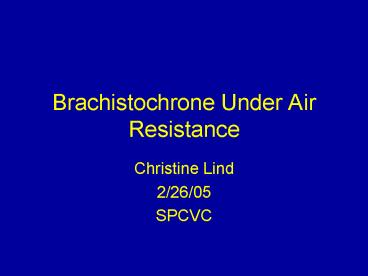Brachistochrone Under Air Resistance - PowerPoint PPT Presentation
1 / 33
Title:
Brachistochrone Under Air Resistance
Description:
Quadratic Formula: ( take the negative root to satisfy v( 0) = 0 ) Many Calculations... parametrization by the slope angle. use of Lagrange Multipliers. Gained: ... – PowerPoint PPT presentation
Number of Views:124
Avg rating:3.0/5.0
Title: Brachistochrone Under Air Resistance
1
Brachistochrone Under Air Resistance
- Christine Lind
- 2/26/05
- SPCVC
2
Source of Information
3
Collaborator
4
Brachistochrone Setup
- Initial Point
- P(x0,y0)
- Final Point
- Q(x1,y1)
- Resistance Force
- Fr
- Slope Angle
- ?
5
Geometric Constraints
- Parametric Approach
- Start by using arclength
- (s) as the parameter
- Parametrized by arclength
- (curves parametrized by arclength have unit speed)
6
Energy Constraint?
- Normally we use conservation of energy to solve
for velocity in terms of the other variables - We have a Non-Conservative system, so what do we
do?
7
Energy Constraint?
- Energy is lost to work done by the resistance
force
8
Energy Constraint
- Non-conservative system
- Constraint parametrized by time
- Constraint parametrized by arclength
9
Problem Formulation
- Boundary Initial Conditions
- Minimize the time integral
- Other constraints
- How do we incorporate them?
10
Lagrange Multipliers
- Introduce multipliers, vector
- Create modified functional
- where
11
Euler-Lagrange Equations
- System of E-L equations
- Additional boundary conditions
12
7 Euler-Lagrange Equations
13
Natural Boundary Conditions
- Note
- v1 is not necessarily zero, so
14
Lagrange Multipliers - Solved!
- Using
- Determine the Lagrange Multipliers
15
First Integral
- Recall
- No explicit s-dependence!
- First Integral
16
Roadmap to Solving Problem
- Given the first integral, can solve for v(?)
- Then use E-L equation to solve for ?(s)
- Then integrate E-L equations for x(s), y(s)
17
Parametrize by Slope Angle
18
Parametrize by Slope Angle
- Define f(?) to be the inverse function of ?(s)
- f(?) continuously differentiable, monotonic
- Now we minimize
19
Modified Functional
- Transform modified problem in terms of ?
20
7 Euler-Lagrange Equations
21
Same Natural B.C.s Lagrange Multipliers
22
Solve for v(?)
- Using Lagrange Multipliers and First Integral
- Obtain
23
Solve for Initial Angle ?0
- Evaluate at ?0
- Obtain Implicit Equation for
- initial slope angle
24
Solving for f(?)
- Rearrange E-L equation
- Obtain ODE
- ( Recall that we already have v(?), ?0, initial
condition f(?0) 0 )
25
Solving for x(?) and y(?)
- Integrate the E-L equations
- Obtain
26
Seems like we are done...
- What about parameters ?1 v1?
- Appear everywhere, due to
- How can we solve for them?
27
Newtons Method...
- Use the equations for x(?) and y(?) and the
corresponding boundary conditions - Now we really are done!
28
Example Air Resistance
29
Example Air Resistance
- Take R(v) k v
- (k - coefficient
- of viscous friction)
- Newtonian fluid
- first order approx. for air resistance
- Let x0 0, y0 0, v0 0,
30
Solve for v(?)
Quadratic Formula
( take the negative root to satisfy v(?0) 0 )
31
Many Calculations...
32
Results
33
Conclusions
- Different approach to the Brachistochrone
- parametrization by the slope angle ?
- use of Lagrange Multipliers
- Gained
- analytical solution for non-conservative
velocity-dependent frictional force - Lost ( due to definition s f(?) )
- ability to descibe free-fall and cyclic motion
34
Questions ?































